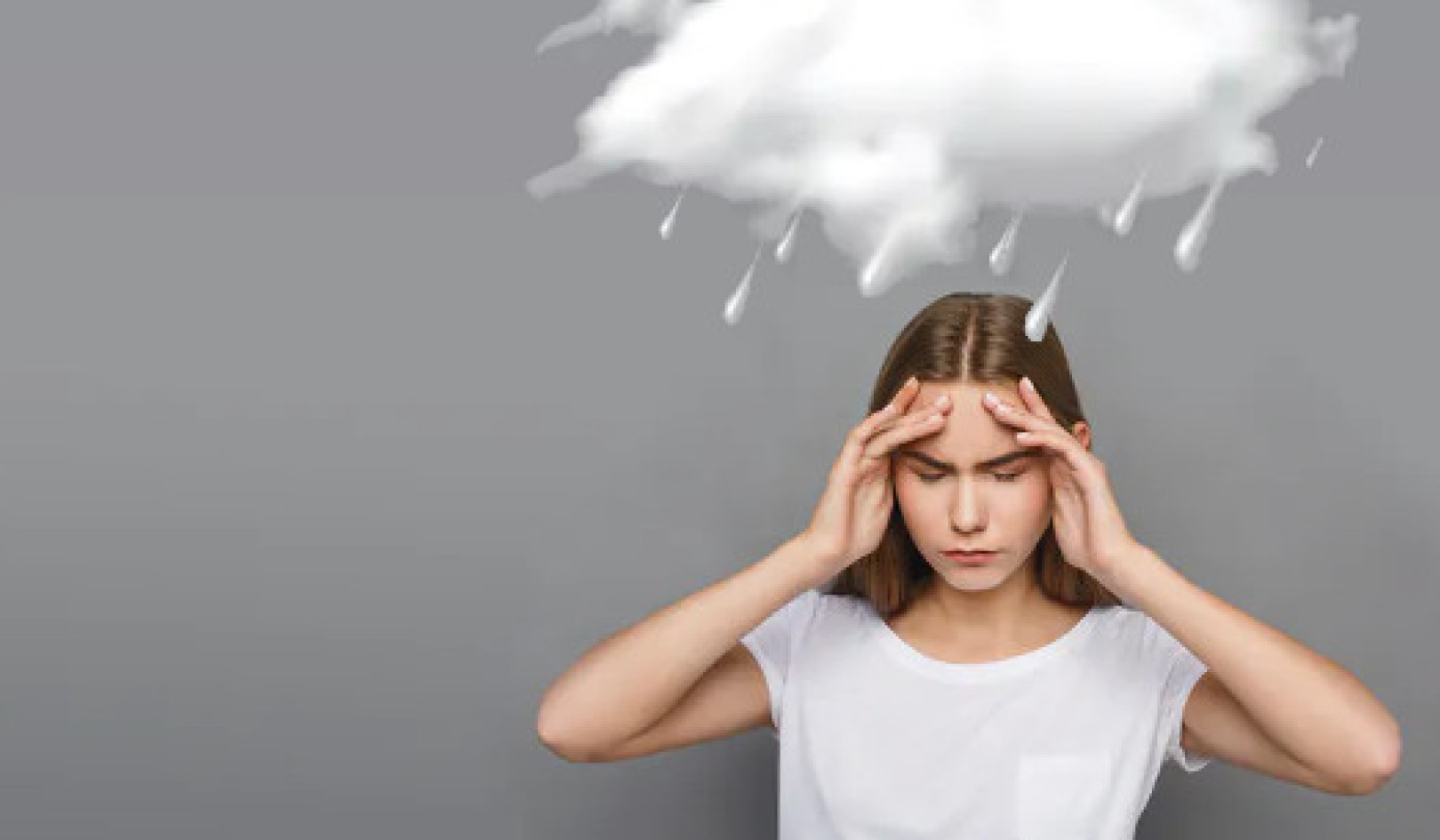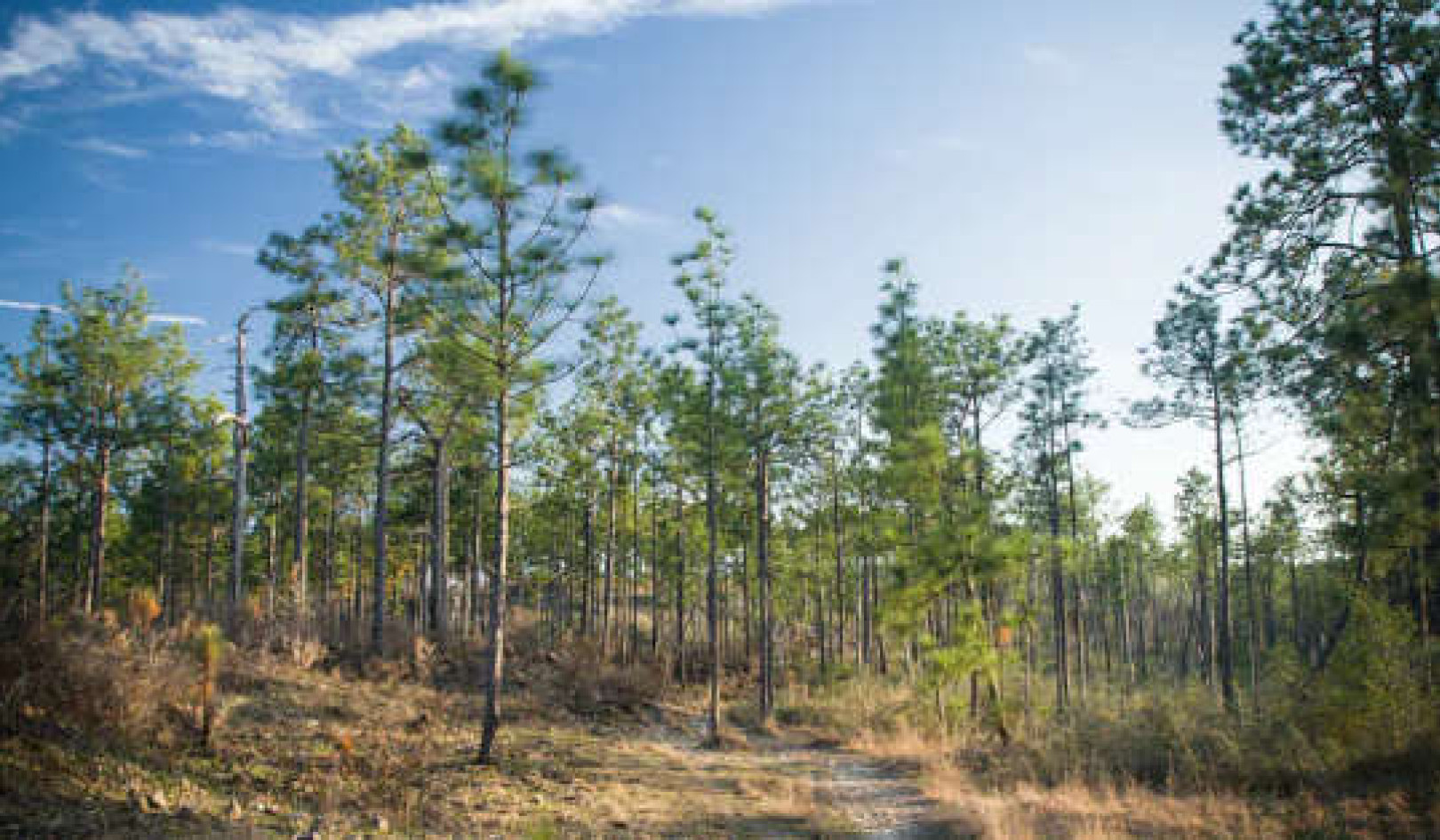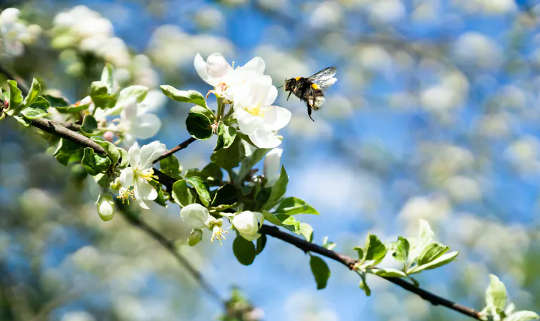
The pollinating activities of bees are far more well known – and appreciated. DES82/Shutterstock
I was lying on the jungle floor of a Malaysian rainforest with a wasp nest dangling 10cm from my nose. I had painted each wasp with a few coloured spots so that I could tell one from another.
I’d been watching these wasps for several weeks: I saw them being born, I saw them fight for a place in society, I saw some rise to motherhood as queen, and others fall to a life of hard labour as workers.
I was here to study the unfolding of social behaviour in the insects best suited to show us – the hover wasps. This was probably the moment I got over my long-held horror of small stinging and biting insects.
Hover wasps live in very small societies of around five to ten individuals. They don’t chase you and they can barely sting. This makes them a good “entry-level” wasp (perhaps you’re tempted?).
Get The Latest By Email
All these individual wasps are capable of reproducing but choose instead to live in a group, where most members sacrifice personal reproduction to help raise the brood of a relative. This is the first rung of the oft-named “social ladder” of evolution. Understanding how and why group living evolves in these simplest of societies may provide critical glimpses into the evolution of more complex stages of social behaviour (as found in the yellowjacket wasps, hornets and honeybees).
Watching my painted hover wasps gave me a unique invitation into the plot of an evolutionary soap opera: there were dominations, submissions, enforced celibacy, births, deaths. The characters were woven together by a matrix of genetic relatedness and pulled apart by temptations outside the family home. Evolution had already decided how the genetic fitness books would be balanced, and the social interactions were my clues to deciphering it. I was hooked.
Twenty years later, I’m still studying social evolution and behaviour, but have welcomed to my stage a broader cast of characters, including some of the most feared and impressive characters of the wasp world, from the much-maligned yellowjacket and hornets to a range of tropical paper wasps, with names that depict a devilish nature – such as Polistes satan.
Twenty years later, I am still justifying why I study wasps for a living to both friends and strangers.
Why should we care about wasps?
What do they do for us?
Why don’t I do something more useful … like study bees?
My personal love story with wasps and their evolutionary soap operas, it seems, is not enough.
Humanity has always had a rocky relationship with wasps. They are one of those insects that we love to hate. We value bees (which also sting) because they pollinate our crops and make honey. We go out of our way to “rescue” a bee from inside a window; but we don’t flinch as we slam a rolled-up magazine over a wasp in the same situation. Our prejudice against wasps is culturally engrained. It stems from our ignorance about what wasps do in ecosystems and how that is beneficial to us.
In 2018, an undergraduate student Georgia Law, a fellow wasp-loving colleague, Dr Alessandro Cini, and I set about finding out whether people really did hate wasps, compared with bees – and if so why. We asked members of the public to rate how they felt about bees, wasps, butterflies and flies (on a scale of one to ten) and to rate how important these insects are as pollinators and predators.
As expected, bees and butterflies were very much loved, and both were recognised for their importance as pollinators. Flies and wasps were very much loathed, but wasps elicited stronger negative feelings of hatred and fear, while flies were merely bothersome, noisy and dirty. No real surprises there.
The shocking result was that no one seemed to know that wasps are important predators. We were quite surprised, especially as the very same respondents had a clear appreciation of the ecological role that bees fill as pollinators. People hate wasps because they don’t understand the important role they have in ecosystems. No wonder I am regularly asked: “What’s the point of wasps?”
This was a eureka moment for me. I’d been singing wasp-evangelism from the wrong hymn book. Most people don’t care about behaviour, they care about what wasps can do for them. And scientists have failed to tell them.
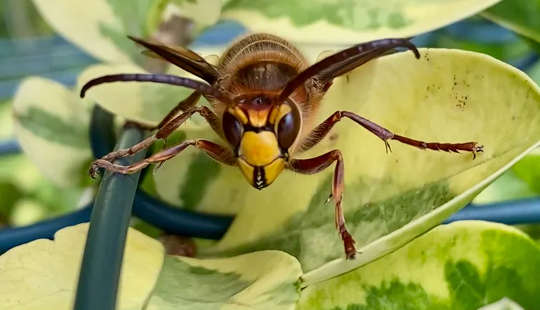 ‘You got me all wrong’. Michael Lefrancois/Unsplash, FAL
‘You got me all wrong’. Michael Lefrancois/Unsplash, FAL
Beyond bees and butterflies
To better justify conserving and managing natural resources, scientists try to define their value to us (humans) in terms of their “ecosystem services”: that is, functions or goods provided by nature that directly or indirectly support the quality of human life, and are therefore of value to society.
Some of these you’ll be very familiar with – like the value of pollination services by bees without which, we’d be hand-pollinating our crops; others you may be less aware of – like the value of soil as a means of recycling nutrients necessary for maintaining the air we breathe and by being the literal bedrock of agriculture.
Insects are renowned for their contributions to ecosystem services. Correction. Certain insects are renowned for their contributions to ecosystem services. For example, up to 88% of flowering plants are pollinated by insects such as bees, butterflies and flies, and we can even put a price on this “service” – greater than US$250 billion (£180 billion) a year, worldwide. Once a price tag is attached to a natural resource, we have a reason to value it and look after it – a kind of minimum wage for nature.
But there are many facets of the natural world that haven’t had a price tag attached. The lack of a price tag doesn’t mean they are worthless, it just means we’ve not bothered to work out which part of mother nature’s jigsaw they belong to. At a time of heightened concern about the global status of insect populations, turning our attention to the forgotten fauna – like wasps – has never been more important.
In the US alone, services provided by bees through pollination and honey production are worth around US$20 billion annually. What’s the economic value of wasps? We don’t know. We know (anecdotally) that wasps eat a lot of insects, many of which may be agricultural pests. But scientists have not calculated how many tonnes of insect pests wasps remove from agricultural landscapes.
The idea that wasps could have an economic value is not at all new. Early entomologists conceded the useful role of wasps in the environment, but lamented the lack of evidence.
In his 1868 book British Social Wasps, physician and amateur entomologist Edward Latham Ormerod acknowledges the predatory role of wasps in ecosystems, but his call to quantify their impact remains unanswered to this day: “It would be difficult to prove absolutely that wasps have a sensible influence in diminishing the number flies and other insects.”
He follows with what remains one of the best lines of evidence in favour of wasps as natural biocontrol agents, albeit anecdotal:
The practical result of destroying all the wasps on Sir T Brisbane’s estate was, that in two years’ time the place was infested, like Egypt, with a plague of flies.
You’d have thought that after 150 years, some enterprising entomologists would have tried to replicate this experiment in a scientifically rigorous manner. Sadly not.
The problem is not a lack of acknowledgement of the possible importance of wasps nor a shortage of talented entomologists. Rather, it is likely to be the ingrained cultural prejudice we have against wasps. Even entomologists shun wasp research in favour working on bees or butterflies.
Here we can learn a lot from the success story of the bees. We have exploited the natural resources of honeybees for millennia. It’s only in the last few decades that scientists have properly turned their attention to the other 22,000 species of bees which we haven’t (yet) semi-domesticated. We are finally starting to properly understand the value and importance of ecosystem services provided by these insects, beyond that of honeybees.
In this spirit, for the last few years, I’ve been trying to put the value of wasps on the map. The public deserves to know how useful these insects really are. What we lacked was a comprehensive review of the evidence that wasps are in fact useful.
And so together with two of my fellow wasp-enthusiasts, Ryan Brock from UEA and Alessandro Cini from UCL and the University of Florence in Italy, we scoured the literature for evidence on the ecological value of wasps. Now, 500 academic papers later, we have arrived at some answers. So what did we learn? Here are some highlights – and some evidence-based reasons why we are wrong to undervalue wasps.
1. Nature’s pest controllers
Wasps are spectacular pest controllers: over 30,000 species of solitary and social wasps hunt a diversity of invertebrates from bugs and spiders to roaches and flies. They are likely to be as effective at regulating the populations of these organisms as are other top predators like insectivorous birds, mammals and amphibians. And what’s more, their short lives and fast reproduction mean they can match fluctuations in prey populations closely.
Solitary wasps tend to be fussy about their prey, focusing their efforts on a single order, or even a single genus. For example, the Pompylidae only hunt spiders and the Eumeninae hunt mostly Lepidoptera (moths and butterflies). But collectively, the solitary wasps (from across 15 families) were found to hunt prey from across 14 different arthropod orders, indicating that as a group, solitary wasps are important in maintaining balanced ecosystems.
Conversely, social wasps are generalists, who opportunistically cease a diverse range of prey. For example, the yellow-jacket wasps (genus Vespula) alone catch prey from at least 15 different orders to feed to hungry sibling larvae in their colony.
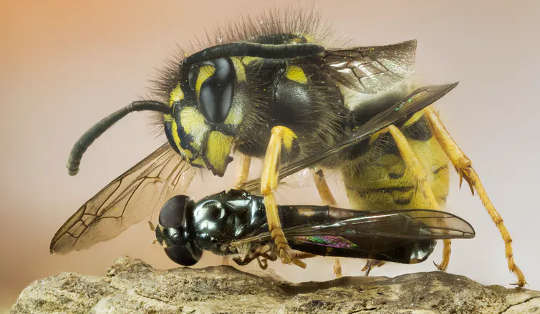 A Vespula wasp catches a fly. Maciej Olszewski/Shutterstock.com
A Vespula wasp catches a fly. Maciej Olszewski/Shutterstock.com
Why should we care about the predatory power of wasps?
There is now no doubt that the chemicals we use to keep our crops free of insect pests are detrimental to wildlife and ecosystems. Although pesticides are designed to kill specific insect species, a wealth of research now reveals the non-lethal effects that pesticides have on non-target insects. We need to be looking for more sustainable approaches to agriculture.
Employing the services of natural enemies, like predatory wasps, is one such solution. Insects have a long economic history in their use as biocontrol agents of crop pests: this is valued at an estimated US$417 billion, and parasitoid wasps (which lay their eggs in or on insect hosts in situ, rather than moving them to a nest) feature heavily in this. But this figure almost completely overlooks the potential contributions of the hunting wasps.
As specialist predators, solitary wasps have great potential as biocontrol agents. Surprisingly, only four species of solitary wasps are commercially available for biological control (the most well-known is the Emerald jewel wasp, Ampulex compressa, which is famous for zombiefying cockroaches). Introductions of solitary wasps to non-native regions have not been very successful, possibly because their life histories are not understood well enough.
A more successful approach may be to exploit local species, and especially social species. Over 100 years ago, colonists in the West Indies toyed with the idea of using social wasps on plantations, reporting anecdotally that crops appeared to be less plagued by pests and there was less need for pesticides when wasp populations were encouraged. But apart from a handful of mid-20th century studies and some encouraging opinion articles, the suggestive potential for using social wasps in biocontrol has largely been forgotten.
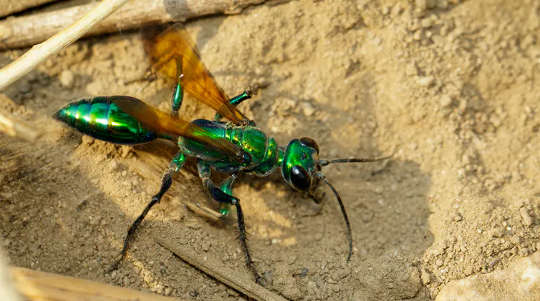 The jewel wasp (Ampulex compressa) is one of the few wasps actively used as biocontrol. Yod67/Shutterstock
The jewel wasp (Ampulex compressa) is one of the few wasps actively used as biocontrol. Yod67/Shutterstock
Together with some enterprising Brazilians, we provided some tantalising evidence for the biocontrol promise of social wasps a couple of years ago. We showed that levels of crop damage and pest populations of the fall army worm (a pest of maize, which causes billions of dollars in crop yield losses every year) were significantly reduced when wasps were allowed to access them.
2. Wasps are pollinators
A whopping 75% of human-cultivated crops are partly dependent on insects for pollination. So it’s not surprising that insect pollination services are estimated to be worth over US$235billion a year worldwide. That’s 9.5% of the value of world agricultural production.
Although wasps hunt prey to feed to growing offspring, the adult hunters are herbivores, just like bees, who visit flowers for carbohydrates in the form of sugar. Much of the year adult social wasps are fed by their larvae, which provide the adults with a nutritious sugar solution in return for the meat they are fed. It’s only when larvae numbers are low (in spring and late summer) that you’re likely to see social wasps visiting flowers. You’ll see solitary wasps, on the other hand, on flowers throughout the year because they don’t benefit from the larval nutrition that their social cousins enjoy.
Some plants are completely reliant on wasps for pollination; we counted 164 plant species across six families. Most of these are orchids which have evolved to mimic female wasp pheromones – some even look like the back end of a female wasp. Males of the Scoliidae and Thynnidae are duped into copulating with a sexy-looking orchid, during which pollen is attached to him and transferred to another flower as he flits from one sexy deceptor to the next.
The vast majority of wasp-plant interactions are, however, non-specific. We identified 798 plant species across 106 families that were visited by wasps. The social wasps in particular appear to be extremely unfussy about what flower they will visit, so long as they can reach the nectar.
To date, there are no studies that allow even a rough estimate of the value of wasps as pollinators. But, given the importance of natural pollinators to our food security and the apparent declines of well-recognised pollinators like bees and hover flies, now would be a good time to start taking wasp pollination a bit more seriously.
This is especially true given that some species of social wasp appear to be relatively resilient to anthropogenic change. In a recent analysis of museum and contemporary biological records, we showed that populations of social wasp species had changed very little over the last 100 years. The yellowjacket wasps in particular appear to be resilient to anthropogenic challenges, like urbanisation and agriculture. Other species, like the hornet, may be more affected by pollutants and loss of habitat.
We need a better understanding of what life history traits make certain species resilient and others vulnerable to our changing planet in order to manage the potential pollinating power of wasps.
3. Grocers and pharmacists
When trying to put a value on insects, one rarely thinks beyond pollination and predation. In fact, these are only part of the services that insects, including wasps, might offer us.
Most obviously, wasps are quite delicious, tossed in a little chilli oil, and they’re surprisingly nutritious. Promoting entomophagy – insects as food for humans – is surely the solution to sustainable food security.
Insects are high in protein and essential amino acids. They use less space and water, emit fewer greenhouse gases and ammonia than livestock. This means that farming them is very efficient. For example, it takes 12 times fewer resources to “rear” a gram of protein from insects compared to beef.
Over 2 billion people around the world consume insects as part of their diet, with 109 species being eaten across 19 countries. And wasps account for 4.8% of all insect species eaten globally.
Wasp larvae have an exceptional dry protein mass (46%-81%) and provide around 70% of our required amino acids, with a low-fat content. The Japanese are especially appreciative of wasp larvae or pupae. With a market price of US$100/kg, demand is so great that sellers have to supplement their supplies with wasp nest imports from abroad.
If you’re not taken by the idea of fried wasp larvae, then perhaps you might appreciate the honey stored in the nest of a honey wasp, Brachygastra mellifica. Or the fact that brewers’ yeast sit out the cold winter in the cosy intestines of an overwintering wasp queen. When the queen wakes up in spring, the yeast hitch a ride to a nearby sugar source (remember that wasps like flowers?).
When we humans are not thinking about our stomachs, we’re thinking about our health. Wasps – specifically wasp venom – can help out here, too. The venom of solitary and social wasps is packed with antibiotics which keeps their prey disease-free and fresh. Larval secretions of social wasps are also rich in antimicrobials, which wasp workers smear over their bodies, brood and nest.
Many of these antimicrobials have potential benefits for human health. They are effective against disease-causing bacteria, and some take specific action against Mycobacterium abscessuss, an important multi-drug-resistant bacterium.
Even the nests of wasps hold medicinal potential, with antibiotic properties effective against Streptococcus mutans (a bacterium associated with dental decay), Actinomyces and Lactobacillus found in the combs of social wasps like Polistes. The solitary mud-dauber wasps (such as Sceliphron) incorporate essential minerals into their clay nests, making them rich sources of magnesium, calcium, iron and zinc – pregnant women and children in parts of rural Africa feast on these “insect earths”.
Many of these antimicrobials have potential benefits for human health. The practical potential of these buzzing medicine cabinets has yet to be picked up by the pharmaceutical world.
But perhaps the most exciting medical potential of wasps are the cancer-cell killing properties of mastoparan found in the venom of social wasps. These are a family of amphipathic peptides which preferentially target cancerous cells over healthy cells. But this too is still far from practical application.
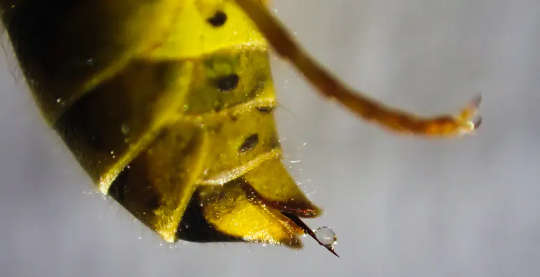
Wasp venom is a promising medical research avenue. David Cardinez/Shutterstock.com
These are persuasive reasons to appreciate the wasp, but are just the tip of the iceberg. For example, wasps also disperse seeds, clean up rotting flesh, and hold promise as environmental monitoring tools.
My love affair with wasps arose out of their fascinating behaviour. The turbulent lives of such tiny beings drew me in and seduced me. I didn’t need to know if they were of “value” to human society or how big their price-tag might be. I cared about them because their mini-dramas unfold chapters in our understanding of social evolution – one of the most perplexing and phenomenal products of the natural world.
Twenty years on, I get that not everyone shares this obsession and fascination. But now, I hope we’ve laid out the evidence for the potential value of wasps, from pest-control to pollination, cancer treatments to sustainable food production. Wasps matter to us. I will challenge anyone who fails to agree that wasps deserve the same attention and respect as the more beloved insects (like bees) that we openly value and protect.
Wasps are important facets of the natural world and have much to offer us, if we’d only take more notice.
About The Author
Seirian Sumner, Professor of Behavioural Ecology, UCL
books_gardening
This article is republished from The Conversation under a Creative Commons license. Read the original article.






